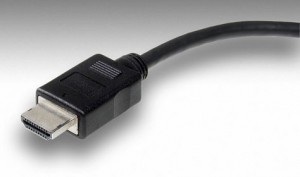HDMI 2.0
Posted on November 15, 2013 by KVMG-CMS | 0 comments

High-Definition Multimedia Interface (HDMI) was originally launched in 2002 to replace the ageing and bulky SCART connection.
Hitachi, Matsushita Electric Industrial (Panasonic/National/Quasar), Philips, Silicon Image, Sony, Thomson, RCA and Toshiba - the founders of HDMI, came together on April 2002 to create an audio/video (AV) connector that was backward-compatible with DVI.
At the time, DVI-HDCP (DVI with HDCP) and DVI-HDTV (DVI-HDCP using the CEA-861-B video standard) were being used on HDTVs.
The first HDMI 1.0 was designed to improve on DVI-HDTV by using a smaller connector and adding support for audio, and enhanced support for YCbCr and consumer electronics control (CEC) functions.
HDMI has the support of motion picture producers such as Fox, Universal, Warner Bros. and Disney, along with system operators such as DirecTV, EchoStar (Dish Network) and CableLabs, while Digital Content Protection, LLC provides HDCP (which was developed by Intel) for HDMI.
HDMI has been through several iterations since then, the fifth of which is the newest version - HDMI 2.0.
HDMI 2.0
Officially unveiled at IFA 2013 by the HDMI Forum, HDMI 2.0 is an improved standard for AV connectivity and the heir apparent to HDMI 1.4 (released back in 2009).
The most important improvement of HDMI 2.0 is the increase in bandwidth capacity (or throughput) - the size of the "pipe" transmitting data from the source to the display.
With the TV industry moving toward Ultra HD "4K," it was clear there needed to be more bandwidth in the connection to handle the future's higher resolutions and frame rates.
HDMI 2.0 bandwidth capacity is increased from 10.2Gbps (HDMI 1.4) to 18Gbps.
You'll need an HDMI 2.0-compatible HDTV if you're interested in watching the full range of 4K Ultra HD source material in the future.
Doesn't HDMI 1.4 already support 4K Ultra HD?
Yes and no. HDMI 1.4 throughput of 10.2Gbps was only enough to support a 4K resolution of 3840x2160 pixels at 24, 25 and 30Hz or to display full 4K (4096x2160 pixels) at 24Hz.
 HDMI 2.0 higher bandwidth has enough room to carry Ultra HD (3840x2160) resolution video at up to 60fps (frames per second). This allows for full-resolution 4K 3D, along with higher-frame-rate 2D content, like (potentially) home videos and computer games.
HDMI 2.0 higher bandwidth has enough room to carry Ultra HD (3840x2160) resolution video at up to 60fps (frames per second). This allows for full-resolution 4K 3D, along with higher-frame-rate 2D content, like (potentially) home videos and computer games.
HDMI 2.0's increased bandwidth capacity enables a whole host of enhancements and features, which include:
 4K Ultra HD at 50/60Hz - i.e. 2160p50 and 2160p60 - four times the clarity of 1080p60
4K Ultra HD at 50/60Hz - i.e. 2160p50 and 2160p60 - four times the clarity of 1080p60- Up to 32 uncompressed digital audio channels (compared to HDMI 1.4's eight)
- Up to 1536kHz audio sampling
- Simultaneous delivery of dual video streams to multiple users (on the same screen) so you can get two full HD shows on the same screen at the same time
- Simultaneous delivery of multi-stream audio to multiple users (up to four)
- Support for 21:9 aspect ratios
- Dynamic synchronization of video and audio streams (dynamic auto lipsync)
- Additional CEC extensions that provide expanded command and control of consumer electronics devices through a single control point for remote controls
Version 2.0 of the HDMI specification does not define new cables or new connectors. HDMI 2.0 is fully backwards compatible with HDMI 1.4 and it features the same 19-pin connectors.
Cables
 HDMI 2.0 does not require new cables. Current High-Speed Category 2 HDMI cables can handle the increased bandwidth.
HDMI 2.0 does not require new cables. Current High-Speed Category 2 HDMI cables can handle the increased bandwidth.
Version 2.0 (like 1.4 before it) is entirely a hardware change. It is not a cable change. You can expect cable manufacturers to proclaim that you need expensive new "Version 2.0 cables" but this is untrue. Your current High Speed cables should work just fine. If your current cable isn't fully up to the High Speed spec, it might not work. In this case, you might get dropouts or sparkles. If you do, a different but not more expensive HDMI cable should work just fine.
Don't expect to see HDMI 2.0 products before 2014. While the HDMI Forum officially released the spec on September 4th, 2013, any HDMI 2.0-equipped devices need to comply with the HDMI 2.0 Compliance Test Specification (CTS). And that's not finished yet. It is expected to be released at some point before the end of 2013.
The spec comes first, then the chip makers design and build the chips, then TV, Blu-ray, and receiver manufacturers build these chips into TVs, Blu-ray players, and receivers. This should result in 2014 models (think CES announcements).
In reality, you shouldn't really worry about HDMI 2.0 at all. No doubt, HDMI 2.0 is very cool, and frees up a lot of elbow room to expand the current TV world. But until there are actual products you want to buy that have HDMI 2.0 in them, you shouldn't worry about it. Even then, your current HDMI 1.4 gear will interface with any new 2.0 gear just fine.
Finally - if, in a few years, you buy a 4K OLED TV, and want to send it Ultra HD (2160/60p) from your 4K Blu-ray player, then yes, you'll need to upgrade your receiver to one that can pass HDMI 2.0.

Bottom line
- No new cables
- Increased frame rates
- No new cables
- Multiple video streams
- No new cables
- Backward-compatible
- No new cables
- And, wait for it...
Need help? Call KVMGalore at 1-800-636-3434 or submit your question.





